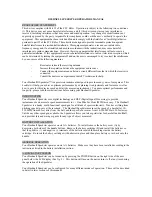
The Packet Radio
“
2 N 1
”
Handbook
by
Buck Rogers
K4ABT
Section 1
;
Packet Radio “The Basics
”
Section 2
;
The X1J4 System Node Operator’s (SNO) Handbook
Section II
;
TheNET X1J4 System Node Operators Handbook
__ Page 36
Chapter 15 Section II
DIGIPEATING: & HOST INTERFACE
NOTE
:
Since
d
igipeating takes priority over other node's network activities, in today's modern network, this is
un
desirable. For proper network operation
it is recommended that the digi function (parameter #23) be set to off.
Each
X1
node supports the functions of an ordinary AX.25 digipeater. Users need not make use of the high-level
networking functions of TheNET
X1
unless they want to. Digipeater owners can upgrade their sites to TheNET
X1
nodes
without notifying the user population. The users won't notice any change. Furthermore, each multi-frequency node is also
a multi-port digipeater. Each frequency is assigned a different callsign.
Often, the same basic callsign will be used, but with different SSID suffixes for each frequency. (For example, K4ABT-7 is
used for the node at 145.770 MHz. The backbone gateway node to 9600 baud’s at the same location is K4ABT-9. Since the
9600 baud backbone node is in the 440 MHz band, the call/SSID may well have been K4ABT-4. In the latter case,
K4ABT-4 was already in service thus the call/SSID of K4ABT-9 was used instead.
Users who have the mailbox option inside their TNCs make it easy for distant users to know what their
mailbox call/SSID
is by employing the SSID of "-1". This format has become a universal user mailbox addressing scheme. It allows a
distant user to connect a node local to a station and issue the call/SSID of a known station in the area of the node using
the stations callsign and adding the -1 SSID.
The chances are great that a connect to the mailbox of the known station
will be made.
INITIAL CONNECTIONS TO THE NODE IN HOST MODE:
PARAMETER SETUP:
After setting up the TNC2 hardware, connect a terminal to the RS232 port. Power up the TNC2
and make sure you see the TheNET
X1
sign-on message. Then perform the following steps:
VERIFY THE NODE'S CALLSIGN:
The callsign of the node (as burned into the EPROM) is displayed in the
TheNET
X1
sign-on message. Make sure it is correct!
Host command lines begin with an ESC character (echoed as "* "). Valid host commands are: C, D, and P.
Esc-C CONNECT
The ESC-C command connects the host terminal to the node. When connected, the host terminal acts like a user that has
been uplinked to the node. All ordinary node commands (CONNECT, INFO, NODES, PARMS, RESET, SYSOP, and
USERS) may then be entered as information lines. However, the host connection automatically has sysop/manager
privileges, so using the SYSOP command is
not
necessary!
Esc -D DISCONNECT
The ESC-D command disconnects the host terminal from the node.
NOTE: For unattended operation, be sure to disconnect the host interface with ESC-D.
Esc -P
password
The ESC-P command sets the "password string" used by the SYSOP command to validate the credentials of sysops. The
phrase may be up to 80 characters long (any excess is ignored), and may include spaces and control characters (except for
CR and LF). Upper- and lower-case letters are treated as distinct from one another in the password string.
Esc
-P with no parameter displays the current password string.
Lines that don't start with an ESC are interpreted as information lines. If the host interface is connected, information lines
are sent across the connection; otherwise, they are discarded.
HOST INTERFACE MESSAGES:
The following messages may be displayed by the host interface:
CONNECTED to callsign
DISCONNECTED from callsign
CONNECT REQUEST from callsign
INVALID COMMAND
















































